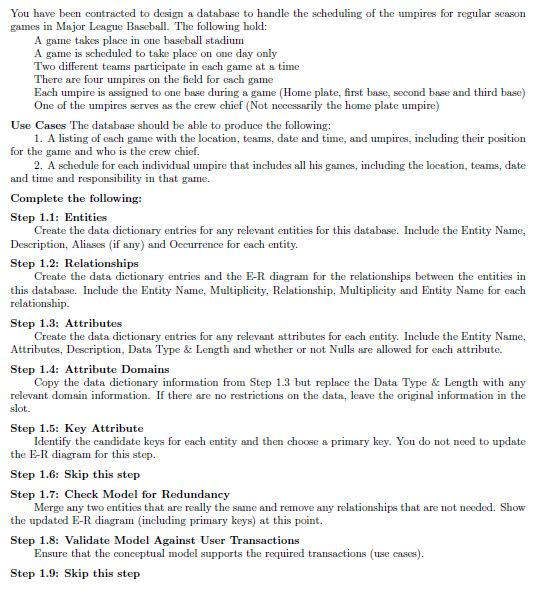
You have been contracted to design a database to handle the scheduling of the umpires for regular season games in Major League Baseball. The following hold: A game takes place in one baseball stadium A game is scheduled to take place on one day only Two different teams participate in each game at a time There are four umpires on the field for each game Each umpire is assigned to one base during a game (Home plate, first base, second base and third base) One of the umpires serves as the crew chief (Not necessarily the home plate umpire) Use Cases The database should be able to produce the following: 1. A listing of each game with the location, teams, date and time, and umpires, including their position for the game and who is the crew chief. 2. A schedule for each individual umpire that includes all his games, including the location, teams, date and time and responsibility in that game. Complete the following: Step 1.1: Entities Create the data dictionary entries for any relevant entities for this database. Include the Entity Name, Description, Aliases (if any) and Occurrence for each entity. Step 1.2: Relationships Create the data dictionary entries and the E-R diagram for the relationships between the entities in this database. Include the Entity Name, Multiplicity, Relationship, Multiplicity and Entity Name for each relationship Step 1.3: Attributes Create the data dictionary entries for any relevant attributes for each entity. Include the Entity Name, Attributes, Description, Data Type & Length and whether or not Nulls are allowed for each attribute. Step 1.4: Attribute Domains Copy the data dictionary information from Step 1.3 but replace the Data Type & Length with any relevant domain information. If there are no restrictions on the data, leave the original information in the slot. Step 1.5: Key Attribute Identify the candidate keys for each entity and then choose a primary key. You do not need to update the E-R dingram for this step. Step 1.6: Skip this step Step 1.7: Check Model for Redundancy Merge any two entities that are really the same and remove any relationships that are not needed. Show the updated e-R diagram (including primary keys) at this point. Step 1.8: Validate Model Against User Transactions Ensure that the conceptual model supports the required transactions use cases). Step 1.9: Skip this step







